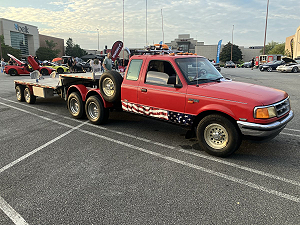Alternator is already grounded via its metal case and the bolts that hold it to the bracket, as long as those are clean, bare metal, then its grounded via the engine ground, larger negative battery cable
And if start motor works, then engine ground is OK
Starter motors require 60-75amps instantly, which is why the main battery cables are so large, that's just for the starter motor
Running vehicles use less than 40amps most of the time if ALL the electrics are on, i.e. heater fan on high and headlights on
That why the Alternators "B+" wire(main wire) doesn't need to be as large as the main battery cables, even if alternator is rated at 100+ amps
Voltage FYI
DC Voltage must travel in a "circle", a circuit
If a device need 5amps then the positive wire must pass 5amps and the negative wire must also pass that same 5 amps to complete the circle/circuit
If the negative wire can only pass 2amps then only 2 amps can "pass thru" the device you want to power, so it won't "power up"
That's when wire size matters, also corrosion on connections, dirty connector lowers that connections ability to pass amps
I.e. a poor battery terminal connection will cause the "click, click, click" when you try to activate the starter motor
That's because not enough amps can pass thru the Circle/Circuit, doesn't matter which battery terminal has the bad connection
And if you were to use a Volt meter to test it, it would show 12volts because its not "disconnected" its just a poor connection and the Volt Meter needs maybe 0.01amp but the starter needs 60amps, so "click, click, click"
Electrons are what power electrical devices, and the electrons actually flow from Negative to Positive
When electricity was first being studied the "positive" was thought to be the source of the electron flow so was named "positive", lol, but they were wrong, and it really doesn't matter just one of those things that pops up now and then
AC voltage works by alternating the flow of the electrons thru the device being powered
Still needs 2 wires but each wire switches(alternates) from positive to negative at the opposite time the other wire does
So the electrons "wiggle" back and forth as the polarity changes, powering the device
So AC still needs a "circuit", 2 wires, but its not a "circle" its a Hula, a "shake your booty" power source, lol
AC power is better for higher voltage and long distances since you are not "moving" the electrons from point A to point B, you are just "wiggling" them
DC is better in lower voltage, short distance application














